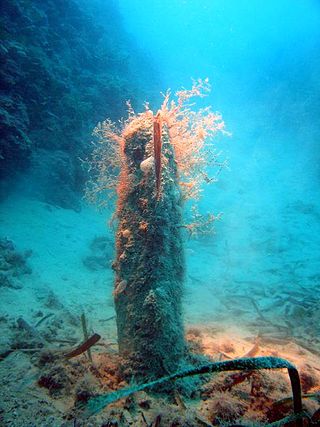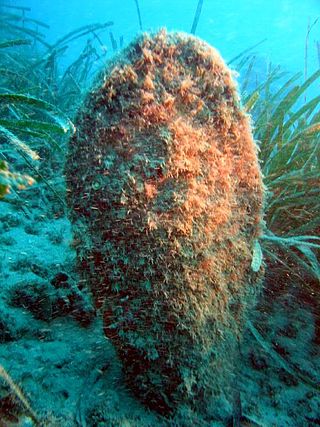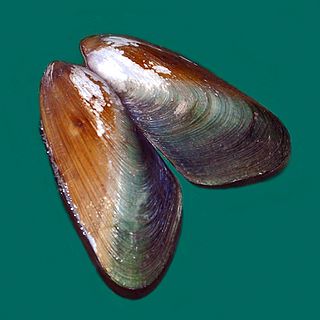
Mussel is the common name used for members of several families of bivalve molluscs, from saltwater and freshwater habitats. These groups have in common a shell whose outline is elongated and asymmetrical compared with other edible clams, which are often more or less rounded or oval.

Bivalvia or bivalves, in previous centuries referred to as the Lamellibranchiata and Pelecypoda, is a class of aquatic molluscs that have laterally compressed soft bodies enclosed by a calcified exoskeleton consisting of a hinged pair of half-shells known as valves. As a group, bivalves have no head and lack some typical molluscan organs such as the radula and the odontophore. Their gills have evolved into ctenidia, specialised organs for feeding and breathing.

The blue mussel, also known as the common mussel, is a medium-sized edible marine bivalve mollusc in the family Mytilidae, the mussels. Blue mussels are subject to commercial use and intensive aquaculture. A species with a large range, empty shells are commonly found on beaches around the world.

Triplofusus giganteus, commonly known as the Florida horse conch, or the giant horse conch, is a species of extremely large predatory subtropical and tropical sea snail, a marine gastropod mollusc in the family Fasciolariidae, the spindle snails, tulip snails and their allies. On average, it weighs over 11 pounds (5.0 kg).

Bithynia tentaculata, common names the mud bithynia or common bithynia, or faucet snail is a relatively small species of freshwater snail with gills and an operculum, an aquatic prosobranch gastropod mollusk in the family Bithyniidae.

Atrina fragilis, the fan mussel, is a species of large saltwater clam, a marine bivalve mollusc in the family Pinnidae, the pen shells.

Integrated multi-trophic aquaculture (IMTA) is a type of aquaculture where the byproducts, including waste, from one aquatic species are used as inputs for another. Farmers combine fed aquaculture with inorganic extractive and organic extractive aquaculture to create balanced systems for environment remediation (biomitigation), economic stability and social acceptability.

Perna perna, the brown mussel, is an economically important mussel, a bivalve mollusc belonging to the family Mytilidae. It is harvested as a food source but is also known to harbor toxins and cause damage to marine structures. It is native to the waters of Africa, Europe, and South America and was introduced in the waters of North America.

Pinna is a genus of bivalve molluscs belonging to the family Pinnidae. The type species of the genus is Pinna rudis.

Atrina is a cosmopolitan genus of bivalve molluscs belonging to the family Pinnidae.

Atrina rigida, commonly called the rigid pen shell, is a species of bivalve mollusc in the family Pinnidae.

Lajonkairia lajonkairii is an edible species of saltwater clam in the family Veneridae, the Venus clams.

Leukoma staminea, commonly known as the Pacific littleneck clam, the littleneck clam, the rock cockle, the hardshell clam, the Tomales Bay cockle, the rock clam or the ribbed carpet shell, is a species of bivalve mollusc in the family Veneridae. This species of mollusc was exploited by early humans in North America; for example, the Chumash peoples of Central California harvested these clams in Morro Bay approximately 1,000 years ago, and the distinctive shells form middens near their settlements.

Pinna nobilis, known by the common names noble pen shell and fan mussel, is a large species of Mediterranean clam, a marine bivalve mollusc in the family Pinnidae, the pen shells.

Pisaster ochraceus, generally known as the purple sea star, ochre sea star, or ochre starfish, is a common seastar found among the waters of the Pacific Ocean. Identified as a keystone species, P. ochraceus is considered an important indicator for the health of the intertidal zone.

The Mediterranean mussel is a species of bivalve, a marine mollusc in the family Mytilidae. It is an invasive species in many parts of the world, and also an object of aquaculture.

Pinna carnea, commonly called the amber pen shell, is a species of bivalve mollusc in the family Pinnidae.

Atrina zelandica, one of several species known as the horse mussel, is a large species of saltwater clam. It is found around New Zealand.

Mytella guyanensis is a species of tropical saltwater mussel, marine bivalve molluscs in the family Mytilidae. This species has been referred to colloquially as the “Trinidad Swamp Mussel” —although not formally confirmed as the common name. It was first described in detail by the French naturalist Jean Baptiste Lamarck in 1819.



















